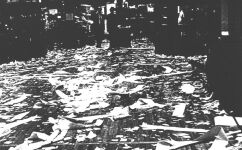
Part 3
| 1968 - Dennis Oppenheim removed 4 tons of paper slips from the floor of the New York Stock Exchange and "transplanted" it to the roof in Park Area South. - "By removing this data from a ground level and carrying it up 16 stories, I am raising the level of the residue that was actively housed on a lower plane. - The building will act as a giant pedestal for the piece." (Removal Transplant - New York Stock Exchange) |  |
| 1970 > Hans Jascha made urban installations out of garbage and employed sounds (screeches, yells) which were amplified by a radio system (picture from the series The salt of the Earth). In another project he covered the floor of his apartment with the neatly sorted garbage of his own daily life: Cheese-wrappers, Teabags, Hair, Shoes, Vegetable Peels, Newspapers, Toilet-paper ... Refuse of the consumer society. He then filmed himself while eating breakfast in the middle of this mess. (Schöner wohnen im Gemeindebau, 1978) | 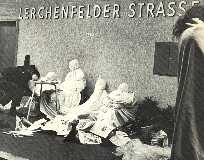 |
1973 – Dennis Oppenheim took a dog that had just died and placed it on top of an electric organ keyboard. He got the dead dog from the American Society for the Prevention of Cruelty to Animals. - Graphite was arranged in a pattern on the floor. Then the German shepherd, which had been kept overnight in a storage room, was dragged through the graphite in a circular manner and placed on the keyboard of the organ. As rigor mortis set in, the position of the dog's body changed, and the sound coming out of the organ changed according to the it’s shifting weight. It was a very funereal piece, yet it was joyful, because noise was coming from the dog. (Untitled performance)
| 1975 - Alison Knowles collected debris in the street. They were small objects that could be held in the hand (a metal spring, a straw, a glass cylinder etc.). She fixed tickets to the objects with instructions how to use them as musical instruments: "twirl by ear", "drop", "scratch", "push in and out". ("Gentle Surprises for the Ear") | 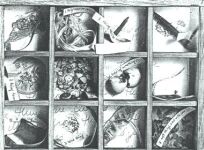 |
| 1980 - Raffael Rheinsberg presents an arrangement of
old shoes and gloves on the floor of the gallery. The
objects were found in a Berlin train-station which hadn't
been used since WW II. The thick leather gloves look
relatively new, they are from modern Germany. But the
shoes are really old, there are wooden shoes, patched
shoes, broken shoes and half rotted shoes. They are shoes
that belonged to forced laborers who were detained by the
Nazi's. They show anther Germany, one that we hope will
never return. The artists sees himself like a researcher,
an archaeologist. He wants to show simple clear objects
that are able to tell their own story. He wants to show
tangible traces of history. (Hand und Fuss) www.stiftungstarke.de/rheinsb.htm - www.einst.ee/Ea/liivak.html |
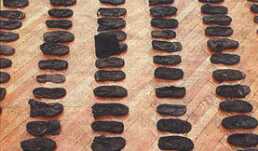 |
1980 - Jo Hanson's Public Disclosure: Secrets from the Street evolved from collecting the sweepings from her San Francisco doorstep into a citywide piece about litter as cultural artefacts and the quality of the visual environment.
1980 > British Artist Tony Cragg assembled
fragments of coloured plastic into figurative works that
could be dismantled and resited. The one I like most is
"Britain seen from the North". The work shows a
large map of the Britain lying on its side with a small
human figure looking at it's (usual) north end (but now
it's west end).
|
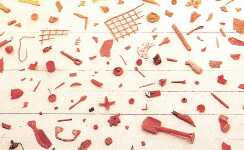 |
19xx - Cecilia Vicueia, a Chilean living in New York, poetically comments on the scale ofthe solid waste problem by setting adrift in the city's gutters and rivers the tiniest, subtlest rearrangements of found rubbish. A bit of paper and a dead leaf may become a tiny raft, noticed by only an incredulous few among the used condoms and oil slicks of the Hudson River near her house.
| 1982 - Ilya Kabakov became interested in the the pathetic remnants of everyday life: receipts, notes, everyday garbage. He started to make crates and folders: to collect, sew together ordinary Soviet garbage (his deepest background and culture) which surrounded him in the studio. He wrote a commentary with each object, detailing where it came from, why and how it found it's way to his studio (The man who never threw anything away) | Text attached to an old sponge: "I don't know how I got it. Probably, it was meant to wash the bathtub. But I didn't use it - I just put it under one leg of the table, so it wouldn't tip." |
1983 - Ilya Kabakov created a fictional character who collected garbage, listened to the "voices" of garbage, who wrote garbage novels and made garabage exhibitions. Tha artist made small paper labels, each with the words of one such "voice" written on it and attached the label to the pice of garbage. Then he strung clotheslines through his studio and exhibited the gabage + label on them. (16 Strings)
| 1983 - Raffael Rheinsberg roams apparently "artless" sites to collect material for his artworks. He explores industrial areas, scrap yards and factories and searches for objects that never were meant to be beautiful but that possesses quality, beauty and narrative. | |
|
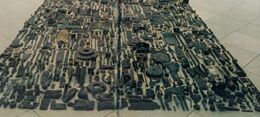 |
1983 - Ilya Kabakov made a box and threw ito it objects of garabage, "an old boot, a paint jar, a sock". Viewers were invited to pick out these objects , one by one, to separate them from the trash heap, to mark their singularity. However to each object were attached lables with curse words of a terrifying degree of agressiveness and malice. It seemed as if the garbage was telling the viewer to "fuck off" and go away. (Box with garbage)
1988 >
British-born artist Rachel Whiteread records the traces
of human presence - and mortality - without spelling it
out. She makes casts of domestic objects such as beds,
matresses, baths, sinks, floors and even a whole room,
including the fireplace. The plaster, rubber or wax
produces a negative form of the object and the space in
or around that object. Often it is the spaces under the
object, the secret place, the favourite hiding place of
children. The objects bear the traces of intensive use;
they show the imprints and marks of the life in which
they had a function. From an interview with the artist:
|
|
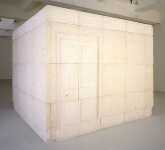 |
1988 - Vito Acconci cannibalised six cars and recombined them into a three-apartment structure. Wood and corrugated steel walls created separate functional living areas. (House of Cars 2)
1990 - Ilya Kabakov installed "Two Walls of Fear" on a former site of the Berlin Wall. Two parallel wooden structures represented the Eastern and Western wall. Rubbish that had been collected by the artist in the now deserted Potzdammerplatz (the pre-war heart of Berlin) hung from wires. Commentary on this debris was printed in German, English and Russian on accompanying white plaques.
1990 > For his New York show the British artist Damien Hirst asked the cleaners at his favorite night-club to save the contents of it's ash-trays for him. The sacks filled with cigar and cigarette butts, champagne corks, matchbooks, cocaine wraps, roaches and stinking wet ash - was flown across the Atlantic, tipped into a giant plastic ashtray and catalogued as Party Time. Other works display containers for clinical waste, placenta's, contaminated medical sharps in nice blue boxes (I'll love you forever, 1994). Damien Hirst has installed a fluffy white lambs in formaldehyde (Away From the Flock, 1994), suspended a steel ball in mid-air (And Still Pursuing Impossible Dreams, 1995), which looks like an ordinary rubber beach-ball and displayed a bull's head, rotting with maggots and hatching into flies, (Paul - The Twelve Disciples). Hirst is said to have mused over the idea of having his hand removed, displayed and quickly photographed, before having it surgically reattached.
1990? - The Beijing based woman artist Yin Xiuzhen collected old furniture and debris from destroyed houses in her neighbourhood and recomposed them into a poetical and somehow nostalgic scene of a ruined city. In an immense installation "The Ruined Capital", she focuses on the memories of a woman grown up in changing Beijing, the centre of mutation, turmoil and revolution in China's modern history.
1991 - Kristine Smock organized 'The Forest for the Trees' in 1991. A city wide project with some two hundred schoolchildren and poets, it began with collecting trash and ended with a striking, community exhibition of giant sculptures made from the findings - many delightful trees, but also a wacky male figure whose shoes are made entirely of cigarette butts and a huge fish stuffed with that farm-ubiquitous blue plastic.
1992 - With modest materials in unexpected combinations, Mexican-born conceptual artist Gabriel Orozco creates objects that celebrate the discarded and mundane in contemporary life. Yielding Stone, a large plasticine ball that the artist has rolled through city streets picking up dust and debris, is the same weight as the artist.
1993? - Mexican-born conceptual artist Gabriel Orozco specified that an empty shoebox should be placed on the floor of the museum, in the corner of a room. Museum directors and curators had problems insuring it, since it could easily get kicked or thrown away. Perhaps especially because Orozco had specified that there be no placard for the work, and it was actually thrown out by a janitor when it was first exhibited at the Venice Biennale. (Empty Shoebox)
1994 > Thomas Wrede photographed the traces of birds who had flown into the glass walls of a pavilion in park in Münster. Many of the birds had killed themselves flowing at full speed into the - invisible - glass. Some of the traces are very bird-like, showing feathers, beaks and wings. Others are more abstract and look like galaxies or clouds. In fact Nature has made a picture of itself in the moment of death and destruction. (Die Vögel stehen in der Luft und schreien)
| 1994 - Ursula Stalder started the project "Collecting along the borders of Europe". She collects random objects on the shores and makes them into melancholic artworks. This lead to poetic exhibitions with poetic names like: Stranded on the shores of Europe - Messages from the Continent - One man's trash is another man's treasure. | 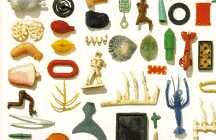 |
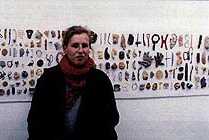 |
1995 - For the 1995 Venice Biennale the French artist César exhibited a massive wall of compressed metal (formerly cars, washing machines, refrigerators, bird cages and computers) called 520 tonnes. He tries to arouse the same enthusiasm in the spectator that he himself experienced when he discovered the blocks of compressed sheet metal in the scrap merchants yard back in 1960.
1995 - John Olsen (Denmark) collects natural objects (dead plants, dead animals) but also the scrap and litter people leave in the landscape. He uses them to make poetic assemblages.
| 1995 - Island into the island - Gabriel Orozco collected random garbage and assembled it into the likeness of the Manhattan skyline. Then it still had the World trade Center ... | 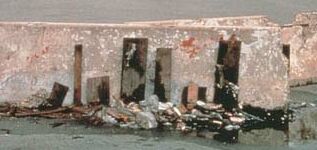 |
 |
1995 ? - A few days before an exhibition in the Smart Museum (Chicago) Mark Dion and several volunteers searched the whole museum for living and dead insects. Mark Dion and an assistant photographed and analysed the specimens. Photographs of the specimens were displayed together with a description of their finding place.
| 1997 - Mark Bain
(an american artist living in Amsterdam) installed the
ashes of the late American architect Paul Rudolph into
the ventilation system of his most famous building, the
Yale Art and Architecture building in New Haven Conn.
Bain, who describes himself as an
"anti-architect," tracked down Rudolph's ashes
(which had been divided between two friends). Then, on
November 1 (the Day of the Dead), eight ounces of
Rudolph's cremated remains were released into the A+A
Building's ventilation system as an appropriate memorial
to the man who built it. The materials list for the Ventilator Project reads, in part: "ventilation duct, electronics, and portion of the architect Paul Rudolph's cremated remains." Bain is quiet about his intentions; he says only that he wanted to "dust the interior with a symbolic residue of the architect." |
|
|
|
| 1997 - Jan Kopp used a deserted spot in the historic
centre of Metz for his "Garden of named
things". The spot is used as an unfinished artwork
where all the components are already present, they just
need to be ordered. Local wild bushes and weeds receive
the professional care of gardeners. Garbage and litter
are washed, polished and laid out in regular geometric
forms. Small shields show the names of the plants and of
the objects, just like in a botanical garden. (Der Garten
der benannten Dinge) The artist is interested in the empty spots in the city (French: terrain vague) that have no definite function and are in a state of transition. In 1993 and 1994 the artist planted massive amounts of poppy seeds in several of these spots in Paris and Berlin. |
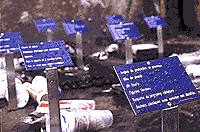 |
 |
| 1997 - Tim Kaulen made a 20 foot high inflatable doll for "Burning Man" in 1997. It was constructed from discarded advertising signage and tethered to the desert floor. (The Sta-Puft Lady, 1997) http://www.iaco-op.net |  |
| 1998 - Starting on January 1st, Nigel Poor collected something off the street every day. The object varied, but it was always something that had been cast off; something that would be considered debris. The artist brought the pieces back to his studio and photographed them. Each image was embossed with the date, street, and city information as to where it was found. --- When you step into a gallery containing the images, it is like walking into a year, as 365 images surround you, one image corresponding to each day of 1998. One would be presented with a concrete account of a year's passing and be surrounded by lost objects acting as a catalyst to remember one's own passing of time. ("Found" project) | Request to reproduce picture was refused |
| 1999 - Thijs Smorenburg (The Netherlands) made a series of inflatable sculptures from rubber inner tyres. Through folding, wrapping with rope and coupling of the inflated rubber tyres the artist creates black, rounded sensual shapes. They are soft, air filled and very suitable for sitting or reclining. Initially they were meant for an outdoor sculpture exhibition, being cheap and disposable. (Rubberish) |  |
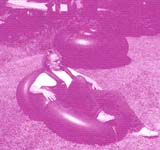 |
1999 - Olaf Nicolai placed an ordinary plastic bag filled with earth and a small living tree in a New York gallery (Greenbag, Variant 2). Greenbag focuses on the relationship between nature and design, and the processes by which apparently natural and given phenomena become artificial.
| 1999 - Qju Ping (China) made yellow water lillies out of yellow rubber household gloves. (Fingerblumen, Berlin) "People are as weak as the thin, yellow flowers", wrote the Chinese poet Li Qing Zhao thousand years ago. His poem provides the main idea for "Fingerblumen" (finger flowers) - artificial water lilies. - http://www.aktionsgalerie.de/ | 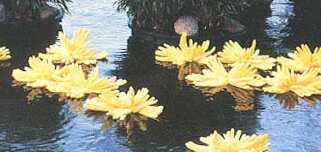 |
| 2000 - Stuart Brisley invented two fictive characters that are deeply interested in refuse and garbage. | It was very generous of him to invite me to stay in the room of the typewriter and enamelled sink collection. - I have now accepted and have been able to survey the collection at leisure. At first sight the collection looked like a huge heap of junk, impressive nonetheless. He said he has been considering building a few paths on the top of it all, as a second layer. There is still a lot of unused space up there towards the ceiling, and he is an enthusiastic mountain walker. - He said that he has already travelled across the top surface several times looking for missing objects. (The viable world of R.Y. Sirb) - http://dump.ordure.org/www.ordure.org/r.y.sirb/viable.html |  |
"Yes it is shit" the
Curator would say and then elaborate on the collection
which now comprises more than four hundred pieces
collected from around the world. He used four rather
unremarkable items as examples:
|
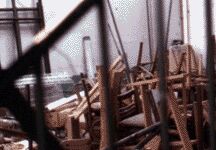 |
| 2000 - Graham Seaton made casts of small found
objects and arranged them into gridded cityscapes across
the vast floorspace Chisenhale gallery (London). The work
creates a horrific model of urban sprawl where the
landscape dissolves as the city spreads over the country.
‘The work explores the way we experience space and expresses the idea that many conditions of spatial experience are unconscious; the unconscious may also be described in terms of spatial journeys or fantasies.’ |
 |
| 2000 - Mo Edoga (living in Mannheim) collected driftwood in the Main-Neckar area. The "Non Euclidean sphere" symbolises our cabled and connected global reality. At the same time it s a piece of ecological sculpture. (Nichteuklidische Kugel, Berlin) | 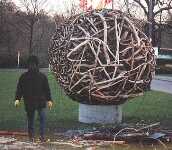 |
| 2000 - Mark Dion excavated a collection of objects at Millbank (parallel to both the old Tate gallery) and Bankside (the new Tate) in an attempt to offer a portrait of a city through it's old and modern garbage (Tate Thames Dig). Dressed up in white coats as scientists and archaeologists, with magnifying glasses and small brushes for props, the artist fumbled their way through a mound of detritus. The cabinets of curiosity take centre stage in this final act. They are a resting place for the detritus and ephemera that has been collected and catalogued during the dig. | The range of material on display isn't as varied as the casual visitor might expect, however it is oddly interesting, especially as the items aren't arranged in any particular order, and each viewer finds their way through bottled eels, broken glass and crustaceans. A HaagenDasz lid and a BMW badge are some of the more modern finds, but the attentions of Old Father Thames are much more homogenous than one thinks; surprisingly, metal from the eighteenth century looks much like metal from the twentieth. |
2000 > Leonardo Drew makes artworks from rows of stacked cotton and wooden boxes, covered with found objects, and caked with rust to suggest decay. Drew's large wall reliefs function as social statements and as meditations on creation and process. His use of such evocative materials as bales of raw cotton, rope, and canvas bags like those of cotton pickers evoke black life under slavery; rusted debris found on city streets connotes urban degeneration. While the materials and context easily lend themselves to such readings, the artist's systematic gridding and complex layering of found objects reference both Minimalism and Abstract Expressionism, engaging a larger discourse of contemporary art theory.
| 2001 - Several artists used old
bottles to make installations in the moat of the
Botanical Gardens in Utrecht. Ineke de Kruyter made floating islands out of plastic bottles (mostly empty detergent bottles) in baskets. In a note she thanked all her pupils who had collected and cleaned the bottles for her. (Untitled) |
Tomasz Vetulani (Poland) made a
bridge out of empty milk-bottles connected with wires.
Every bottle contained a hand-written note but it was
impossible to read them. (Bridge) Ellen Menschaar (Netherlands) made "water lilies" out of plastic soft-drink bottles filled with white polystyrene spheres. The "flowers" floated freely in the water. (Untitled) |
|
||
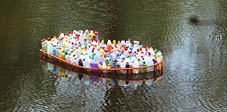 |
 |
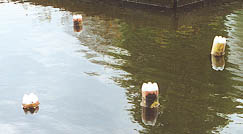 |
2001 - Chinese artists Gu Wanda, created an 80-foot mural of psuedo-words made of real human hair. The piece stretches over several walls. It uses human hair from all over the world and shows Sanskrit, Arabic and Chinese characters. It was originally displayed at the U.N. - Wanda also mailed a piece to the museum with special orders to spread a substance out in calligraphic letters. The substance they received was simply labeled "human placenta." The letters ended up spelling out a message having to do with China's stance on limited childbirth. - Art graduate student Matthew Gross opened the box when it arrived. - "A wave of slight disgust overcame me as I first examined the bagged contents, but then, as I placed my gloved hands into the material, sifted through the ground material (both fine and coarse), I began to appreciate the highly textured organic quality of the material." - http://wildcat.arizona.edu/papers/95/9/04_3_m.html
| 2001 - Marianne
Dommisse made a series of portraits of dead animals. Many
of these she found on the street, but she also
photographed birds killed by oil slicks, dead lambs at a
farm and even dead mice she found in her own atelier. But
most of her animals are birds that were killed by cars
and that she found at the roadside. Therefore she calls
them: "Asphalt Flowers". When I find a dead animal on the road I sit beside it on the side of the road. Other people just pass it by - how is it possible that they don't notice it? And when I photograph them other people think I'm crazy: "Why doesn't she simply wait for the garbage men to take it away? " |
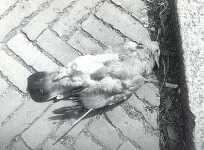 |
| 2001 - German artist Florian Göttke's installations reveal his social commitment to his surroundings. He observes the way nature regains territory in parks and zoos. In Rotterdam he presented the carefully selected and arranged remains of a house as "Landscape - Mountain View". - http://www.wdw.nl/ENG/text/projects/tpa/fr_tpa.htm | 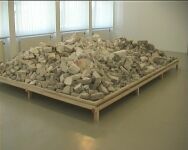 |
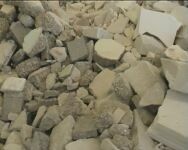 |
Installations, improvements & decorations - often illegal or unwanted
1968 - With his series of the Site Sculptures, Douglas Huebler is experimenting with the concepts of "sculpture" and of "place". His intervention is documented by maps, photographs and other information. - For Site Sculpture Project New York Variable Piece #1 Douglas Huebler installed site-markers that travelled through the city. Sometimes they were transported randomly in horizontal directions (by cars and trucks), sometimes they were stable and permanent, and sometimes they were transported randomly in vertical directions, by elevators.
| 1969 - John Baldessari and George Nicolaidis affixed stickers on public telephones, signposts, etc. along the boundary of a ghetto of Seattle. The label said: | Boundary : A section of a city, especially a thickly populated area inhabited by minority groups often as a result of social or economic restrictions. |
1969 - Peter Hutchinson built an Underwater Dam. It was built from sand bags, under three meters of water in a Tobago bay, in the Antilles.- http://territoiresinoccupes.free.fr/art/partie211.html
1969 - For - Sound Enclosed Land Area - Dennis Oppenheim buried four tape recorders in cages at four points in Paris, delineating a rectangle of 500 by 800 meters. Each tape loop projected a voice repeating its respective cardinal point: North, South, East, or West.
1970? > The 75 years old "artist" Tsang Tsou Choi's, a poor worker with certain mental difficulties, belongs to the lowest, marginalised class in Hong Kong's social hierarchy. He was born in Liantang Village, Guangdong Province, China and came to Hong Kong when he was sixteen. For the last forty years, he has been writing graffiti at every corner of the territory, from Central to New Territory via Kowloon. According to himself, he studied the ancestral tree of his family, and discovered that most of the land of Kowloon belonged to his ancestors! - Claiming to be the "King of Kowloon", he uses his natural, rough and strong black calligraphy to recount a kind of family history which is something between pure fantasy and reality. Writing graffiti has become his quotidian exercise while confrontation and troubles with police and other people on the street become a way of survival. His "work" is extremely original, unique and impressive, full of imagination and consistence, and the art and culture world of Hong Kong, now is promoting Tsang Tsou Choi's work.
1970 - Rasheed Araeen designed a performance where he threw floating discs on to the water. He did this both in London, on the Thames, and in Paris on the Seine:
| 1974 - Ant Farm (a San
Francisco collective) upended ten Cadillacs along Route
66 near Amarillo, Texas. Ranging in vintage from 1948 to
1962, the cars were buried to their midsections in what
can only be described as a requiem for the golden age of
the American automobile. Cadillac Ranch has now
become a public roadside attraction, now rusted and
graffiti-covered. The video Cadillac Ranch Show is a document of this site installation which was commissioned by Texas millionaire Stanley Marsh III when the 10 Cadillacs were buried fin-up in a field. The image of ten Cadillacs pointing upward against the sky is a comically subversive homage to the rise and fall of the tail-fin as an icon of post-war American consumer excess. Footage of the burial of the cars is intercut with Cadillac commercials that promote a fetishized ideal, the ultimate American Dream. |
 |
1976 - The video Junkyard Levitation is a visual pun by Bill Viola on the concept of "mind over matter," as a man attempts to levitate while lying prone in a junkyard. Writes Viola, "Scrap metal technology and video technology are united to temporarily break the known laws of science and prove that psychokinesis is valid within a given frame of reference.
| 1976 - H.A. Schult filled the Plaza San Marco with
350.000 newspapers as his unofficial art-project for the
Venice Biennale. (Venezia Vive) http://web.archive.org/web/20011217142821/http://cnn.com/TRANSCRIPTS/0005/21/i_tac.00.html |
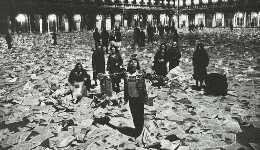 |
| 1977
> Harald Näegeli, also known as the "Sprayer von
Zürich" drew skeleton-like stick-figures on many
buildings in the city. He saw himself as a serious artist
with a very personal and original style. He was one of
the first graffiti artists to be caught and convicted.
His art cost him nine months in jail and his job as a
professor. Harald Naegeli became famous in Germany Naegeli through his Cologne "dance of the dead". Overnight black skeletons appeared on many walls in Cologne and shocked the citizens. Death beat the drum in the multi-storey car park of the music-school. The city dispatched a cleaning battalion immediately. But Naegeli did not give up. Where one skeleton had been, two or three danced next morning. Again the cleaning squad came. Naegeli answered with a Crucifixion (Kreuzigungsgruppen). But these were removed too. Naegeli looked for revenge: he sprayed large lightning bolts on the electricity-boxes of the city. But not only there. Soon these revenge characters were everywhere in Cologne. |
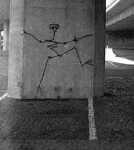 |
| Afterwards Naegeli left the city. The Naegeli-fans from Cologne continued the project of the master. Now small black dogs appear everywhere in the city. Their belly is round, and the eyes shine in a green colour. Black, uncanny dark men stand on the walls. Yesterday they were not yet there. Sometimes one sees them together with a red woman. She is painted with a thick brush. Fast, with only two, three lines. Heads and faces are everywhere. With two brush lines someone made a devil with pink horns and two exclamation marks for eyes. Rats with long spider-legs run on a 100 meters long, white wall. | 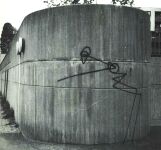 |
| 1977 > Billboard Liberation Front - Jack Napier and Irving Glikk attended an event sponsored by the San Francisco Suicide Club. Together with 24 other urban adventurers they climbed a factory roof and improved two existing billboard messages. They were apprehended by the authorities. Inspired by this experience Glikk and Napier founded the BLF and started improving billboards around San Francisco. http://www.billboardliberation.com | 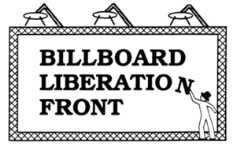 |
| 1980 > The artist and arthistorian Lars Vilks had since 1980 had a long fight with the swedish authorities about the two huge monuments Nimis and Arx. Though uncountable trials had been going on for more than a decade, the authorities were not capable of removing the pieces. Nimis is a construction of driftwood and rests from the cutting areas. It is situated on the peninsula of Kullaberg in the south of Sweden - now an independent state Ladonia. In 1991 Vilks started another project next to Nimis: Arx (lat. "fortress"). This time he was using concrete and stones, the concrete to be carried down to the place in a rucksack. Also this piece was taken to court by the authorities and 1995 the Supreme High Court sentenced the artist to pay fines. http://www.aim.se/ladonia/ | 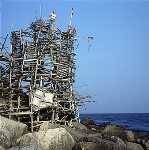 |
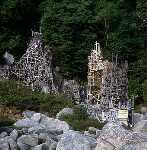 |
| 1980 > Keith Haring started his career as a graffiti-artist in the New York metro. He drew his stylised cartoon-figures on unused advertisement spaces. While going to the bakery he met the photographer Tseng Kwong Chi who followed him on his metro-expeditions and photographed his work. Without the photographs none of his early work would have survived, because all of it was illegal and temporary. Keith Haring died of aids on 16 February 1990. |  |
| 1980 > Tyree Guyton, a painter and sculptor began The Heidelberg Project in the mid 1980s. The project is named after the neighbourhood street on which it is located. In this neighbourhood, with its abandoned, drug infested houses, he gathered discarded objects from the streets and used them to decorate the outsides of the houses, transforming them into urban art, or to make roadside sculptures. With the help of his grandfather, Sam Mackey, and Smith, Guyton painted the objects he attached to the exteriors of the houses and surrounded them with everything from tires to toilets to tombstones, depending on his theme for the house. He also filled empty lots with rows of old drinking fountains and old appliances. | Despite the honours he has Guyton's offbeat street works have generated considerable controversy in his home city of Detroit. Some neighbourhood residents apparently viewed them as eyesores, and the artist has been ticketed for littering. In addition, reportedly after complaints by neighbourhood residents reached the ears of Detroit's former mayor, Coleman Young, four of the abandoned houses that Guyton had decorated with objects were suddenly demolished by the city government in November of 1991. www.heidelberg.org |
1982 > Paul Armand Gette studies the weeds growing in the public spaces of cities and he gives official botanical name-plates to these otherwise unnoticed plants("Plantaginacae, Plantago Major L. euras."). Common weeds often have very beautiful Latin names. By naming the plants, and giving them more respect we get a chance to see them with fresh eyes.(Kassel ist ein botanischer Garten)
1985 - To improve the sanitary situation Mathias Schönweger attached rolls of toilet paper to 20 trees in a wood. (Hygiene-Installation in einem verdreckten Wald, Vinschgau)
1985 > For over ten years
Jac Leirner has made art from leftovers that were
initially meant to circulate, like devalued bank notes,
business cards, shopping bags, and used envelopes.
Leirner has said that she does not actively search for a
material to work with. It suggests itself by its
insistent recurrence in her life.
|
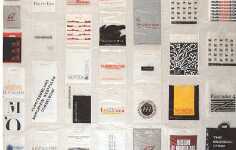 |
| 1987 – The Berlin duo p.t.t.red filled Berlin telephone boxes with telephone books. Thereby they disabled their normal use and questioned the function of public services. (Telefonbuchinstallation). For the project "teilimaginäre system" (1988) they polished the long disused rails of the Berlin-Kreuzberg streetcars thereby restoring the historical transport lines. In 1989 they painted the road-markings on the underside of a car-bridge, thereby adding an optical element to the car-noises that can be heard from above. |  |
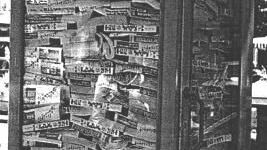 |
| 1988 > Between 1988 and 1990 Stefan Micheel and HS Winkler plotted a large scale "Golden section through Berlin". They picked five spots on the golden-section of an imaginary straight line through Berlin. Then they gilded one steel element of the five buildings in those spots, for example one girder of a railway-bridge and one pipe of a gas-container. | 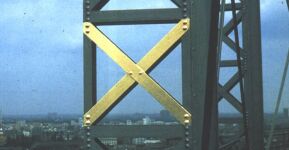 |
| 1988 > "Space Invader", an anonymous artist from Paris has placed more than 300 bitmaps made from bathroom-tiles on the facades of public buildings. The artworks usually measure 25*20 cm. Placements are mostly intuitive, but he prefers street corners. He uses the name "Space Invader" because his tiles carry pictures from this arcade game. Because he uses high quality glue it's almost impossible to remove his artworks without damaging the building. The authorities have said that they are not amused nor impressed and that they'll treat him like any other illegal graffiti artist if they catch him. | 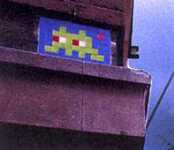 |
His art can be found in , Amsterdam,
Antwerp, Paris, London, Lausanne, Tokyo and Los Angeles.
"Initially I adopted a pseudonym for security reasons, but later it enabled me to play games with this fictional character. I like to put little grains of sand in the mechanism of society. It's an amusing game. I make the first move by installing my artworks at night. Then the inhabitants of the city make the second move, by looking for my artworks, by speculating about them and even by removing them." http://web.archive.org/web/20011217142821/http://www.space-invaders.com/ |
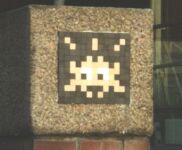
|
1989 - Eva Wohlgemuth and Andreas Baumann mounted four Aluminium Plates (27x27 cm) exactly to the north, south, east and west of the tower of St.Stephan's cathedral and in a distance of 100 times it's height ( 134.6 meters - same like Cheops Pyramid). If you visit Vienna and bring your compass, you still can find them. http://www.t0.or.at/~siberian/theopge.htm
1991 - Paul Hay built a framework of a house out of wooden beams and mounted fluorescent lights inside the structure. The house was sited under an overground powerline at the University of Western Sydney. The electromagnetic radiation was so great that the lights lit up. (Light House)
| 1991 - CHRISTIAN HASUCHA toured Europe in a van full of tools. He made artworks while on the road and installed them in urban spaces. Sometimes he wondered if they would be discovered before they decayed. (Public interventions - Expedition LT 28 E) | 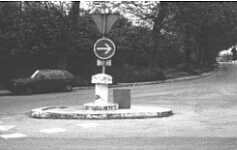 |
 |
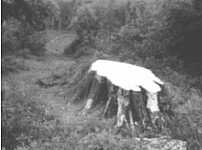 |
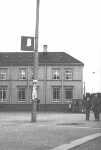 |
1991 - Christian Hasucha attached a ladder and a 5 meter high platform to a lamppost in Koeln. Each day one visitor would be given the combination of the combination lock that gave access to the platform. The platform was situated in a monotonous urban quarter, close to a large parking lot. Once on the platform the visitor heard a combination of environmental noises (mostly cars) and sparse percussion music from a loudspeaker. This set-up should intensify the urban experience of the spectator. (Ueber die Stadt, Die vertonung der Umgebung)
1992 - Helen Escobedo installed 100 blue umbrellas in a high tree. (Regenschirmbaum)
| 1995 > Angie Hiesl attaches a chair to the facade of a building and invites passers-by to sit on it for a while. The chair is fixed at a height between 3 and 6 meters. This artwork has been shown in Germany, France, Brasil and the Netherlands. | 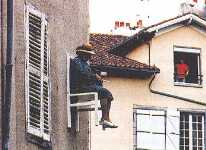 |
| 1995 - Mark Dion removed two cubic metres of earth behind the city walls of Fribourg in Switzerland (used for centuries to tip refuse), transferred it to a museum. The city's detritus, accumulated over hundreds of years, was cleaned, categorised, and displayed on shelves around the museum space. (History Trash Dig) The final installation also consisted of a table of fragments of cleaned earthenware that could not fit onto the shelving and the remaining pile of earth into which a shovel was sunk. History Trash Scan (1996) followed a similar process. On this occasion, however, all the detritus was removed from the base of a castle in Umbertide, Italy, and displayed on a number of makeshift tables. | 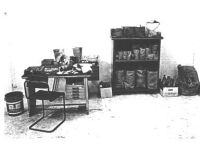 |
| In 1997 a large container was filled with dredge from Venice's canals. Much of the dredge was sifted through and catalogued in front of an audience in a makeshift laboratory. The cleaned detritus, displayed on a system of shelving and in a number of treasure chests, was simultaneously exhibited with the laboratory in a parallel room. The dredging led to confiscation of the installation by the Carabinieri (the local police). All archaeological material in Italy belongs to the state even before it becomes part of an installation. By the same logic, an international travelling installation would become an illegal export. The Dion installation was the immediate legal property of the state (its constituent parts had been illegally extracted without a permesso from the Venetian canals) and it is now housed in the Palazzo Ducale of Venice. Perhaps even performance artists could benefit from archaeological training (which includes the transferable skill of diplomacy!). (Raiding Neptune's Vault: A Voyage to the Bottom of the Canals and Lagoon of Venice) | 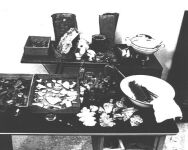 |
| 1995 > Roman Signer parked an unassuming little pickup truck next to fire hydrants, connected them to the city water supply with a simple pipe, and opened up the rear of the vehicle. His rebuilt Piaggio has a water basin on its bed, out of which a stream of water loudly shoots up against the ceiling, afterwards pouring down into the basin. The water runs through a drainpipe and splashes onto the street. With this amusing transformation of the customary fountain sculpture, Signer is successful in following the tradition of the Swiss engineer-artist, such as Jean Tinguely. Moreover, since the sculpture is mobile, Signer offers a practical solution for the various times of the year; when there is a demand for fountain water at various sites (Fontana di Piaggio). | 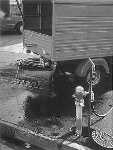 |
| 1996 - Maurizio Cattelan sculpted fake homeless persons from showroom dummies, blankets and garments. Sometimes he placed them in the gallery, sometimes out on the street (Andreas, Mattia, Gerard 1999 lifesize plastic dummy, clothes, shoes) |
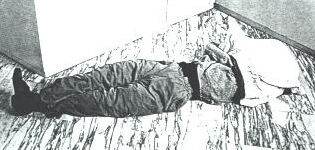 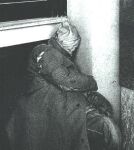 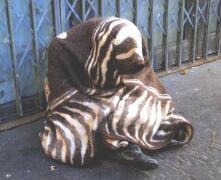 |
1996 - Gabriel Orozoco, a Mexican artist created "Long Yellow Hose" for the MCA in La Jolla. It was an outdoor installation made of 1200 feet of standard yellow plastic watering hose. The hose, which wove in and out of MCA's garden symbolised the intricacies of the underground watering system that keeps the garden alive in an arid desert climate. But viewers who wandered through the garden often wondered why the gardener had left the hose out.
| 1997? > An anonymous artist called "Influenza" (Jeroen J.) is adding - sometimes overlapping - black and white dots to the cityscape. Normally these are used for the calibration of aerial photography and cartography. In the middle of every "official" marker is a steel nail marking the exact coordinates. The "cloned" markers lack these nails, but surely the must be a pain in the ass for the official cartographers. - http://flu01.com - http://influenza.animen.com/ | 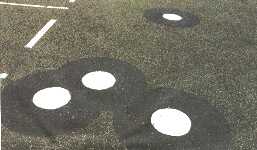 |
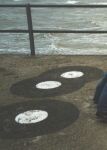 |
1998 - Michel Francois (Belgium) suspended a piece of string over a river (A flux tendu).
| 1998 - An anonymous individual has been placing this stamp in art books in the Rotterdam library. - The weblink points to a (now defunct) webpage that only held a counter. During the whole liefetime of the website not one single visitor clicked on the page. - Then the artist changes his strategy - he's still putting stamps in the books, but now he's pretending to be several different individuals. |  |
1999 ? - Erik Hombrink (?) made several large, heavy artworks out of concrete and placed them in public spaces in Rotterdam. Two concrete slabs with text were placed at the Schouwburgplein. Another concrete slab was placed upright inside a telephone box. A concrete block with a small metal chimney was placed beside a tree. Some artworks survived just a few days, other stayed for two weeks. The telephone-box slab was removed from the box within 1-2 days, but lay next to the box for many more days.
| 1999 - Bonhansa, an artist from Utrecht has put up a box with a "guestbook" in the middle of a higway-crossing. ("Dreamplace 1") This is forbidden territory. Recently he went to revisit the site to see if anyone has signed the book. He was spotted by the highway police. They didn't fine him however, they just put him off at the other (legal) side of the highway. | 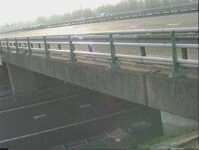 |
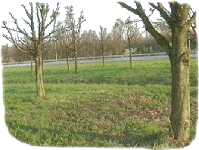 |
| 1999 - On Friday night, shortly after midnight, 54 year old artist, Harald Naegeli sprayed a black figure on the wall of the university hospital. Suddenly two of the hospital security-guard service approached. The artist tried to flee and defended himself with his spray-can. Then guard used his own spray-can and hit Naegeli with a charge of pepper-spray. The artist resisted arrest, fell to the ground and received blows to the head with an iron object. "That probably was the flashlight", assumes Naegeli. Two wounds had to be sewn, one over the eye, one behind the ear, but "the treating physician was obviously a friend of my art", says Naegeli and smiles. He threatens the hospital administration with a lawsuit if they repaint the wall: "the wall is worthless, but the work of art costs 20,000 Swiss Franks." | 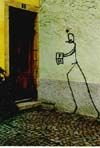 |
| 1999 - Lee Littlefield creates outdoor, pop-up sculptures out of organic materials. It is not easy to get his work installed because of the red tape and complex rules laid down by the city's parks department. Much to the delight of commuters, Littlefield has taken to installing his "pop-up" yellow-painted wood sculptures in flood zones and along city highways in unexpected and unlandscaped sites. (Eye Halo, 22 feet tall, Big Ball Cross, 18 feet tall) | 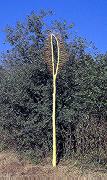 |
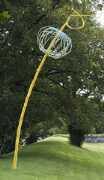 |
| 2000 - An artist with the pseudonym Zevs (Zeus ?) walks the city-streets at night. He draws the outlines of shadows cast by streetlights on the pavement, using white or grey paint. He has made these artworks in Paris and Montpellier. "my work is not a message, but an act of poetry. I cover the city streets with luminous signs and patterns." http://web.archive.org/web/20011217142821/http://www.space-invaders.com/ | |||
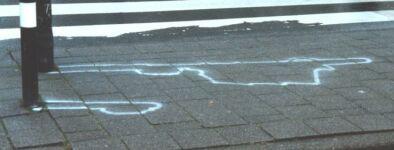 |
 |
 |
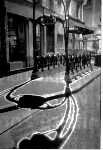 |
| 2000 > An unknown individual has been spraying a distinctive sign on switchboxes along the Dutch railroads. It is different from the usual tags and the artist chooses switchboxes that are far out in the fields, and not near railway stations. An article has been written in the NRC newspaper (Het teken, S. Montag, 2-12-2000) stating that the sign can be seen throughout the country. No further details are known. | 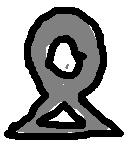 |
| 2000 > H.A. Schult placed an illegal sculpture on top of the the Severinsbrücke in Köln. This wasn't part of a city plan or officially sponsored arts project. It was put there by the artist in a daring and unlawful swoop using a helicopter. Despite the protests of the city's authorities, the artist is adamant that the sculpture stays put. Other projects by H.A. Schult include large armies of "garbage people" who symbolize humanity. The garbage people have visited Paris and Moscow and one miniature garbage-person may be launched into space. Another project is a traffic jam of 100 whitewashed car-wrecks on top of the Altstadttunnel in Düsseldorf. |  |
 |
| 2000 - Serge Spitzer has employed hundreds of locals to carefully place thousands of beer glasses onto the steel stanchions on the Zoobrücke in Köln. The vibrations caused by crossing traffic will cause the glasses to fall and break deep inside the structure of the bridge. "This space inside was never used for anything except maintenance work. I thought it should be in a way discussed, rediscovered, and in a way reviewed. I thought it would be interesting to drive every day above the bridge thinking about something fragile happening inside. " http://www.cnn.com/TRANSCRIPTS/0005/21/i_tac.00.html | 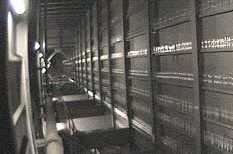 |
2000 ? - A small steel platform designed by Christian
Hasucha is attached to a lamppost. Passers-by can stand
on the platform and find a moment of contemplation in the
middle of a busy urban day. (Geräte: Intervention P)
|
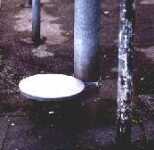 |
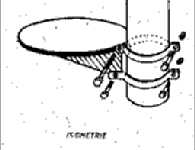 |
2000 - There is an artist operating in and around Newcastle Upon Tyne, England, who erects brass plates to buildings in the city centre. They are all about 5" squared and have differing messages. Often they are deadpan jokes, prices informing the exact value of the building, or fake directions. I have seen 10 or so such plates so far and more are being erected every month. I don't know what action the authorities are taking, but they are great. I, at least, am enjoying them. (... writes Heather, from England).
| 2000 - The Dutch artist Chris Westen claims to have created the largest mobile artwork on Earth. It consists of 2000 brightly coloured scarecrows. At the moment it stands in a field in East Groningen. The individually painted scarecrows should stimulate people to find their own way in life. In 2002 the artwork will move to China or Australia. Then it should make a tour around the world and return to the Netherlands in 2100. (Bur Earth) | 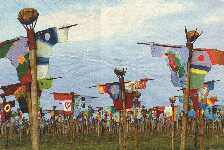 |
| 2000 - In Amsterdam the Icelandic Love Corporation has placed a small sign on a facade (in the Warmoesstraat) saying: | In memory of feelings felt |
| 2002 - The London based group "Space hijackers" installed tiny farm-models in the City of London. (CITY FARMS, a pleasant way of bringing country life to the city) - One sunny Sunday afternoon we sneaked into the square mile. Armed with some super glue and a large amount of model railway scenery, we set about turning the concrete jungle, into a luscious green pasture. The farms were left then to be cared for by the workers of the city, a small gift from us to them. - http://spacehijackers.co.uk/html/projects/farms.html | 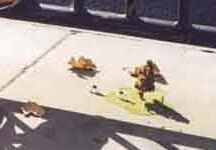 |
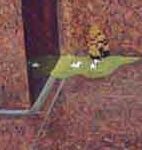 |
| 2002 - Laurent Goei installed several heated cabins in the city of Zürich. People could sit down in the cabin and enjoy the view of the surroundings. At the same time they formed a living art-object that could be examined by the passers-by. These human exhibition platforms play with privacy and public space, with voyeurism and exhibitionism. (Display #3) | 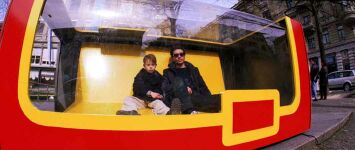 |
| 2002 - Peter Regli (Switzerland) flew 16 Pirate flags from the flagpoles at the Bellevue. The designs were made by children aged between 3 and 16 years. (Reality hacking) - Most art is shown in museums but I use public space. Most of my installations are removed after a certain time. The work exists briefly and is only retained in the memory of the viewer. The artist withdraws behind the artwork and becomes anonymous. |  |
 |
Enhanced sense of place - Poetry & theatre
1965 - In Allan Kaprow's "Pose" Polaroid photo's of various actions were attached to the spot where the action took place, and left there. Actions could be very simple like placing a chair between rail-tracks and sitting on it for a while.
1965 - In Allan Kaprows "Calling" wrapped figures were left in public places and called on the telephone - in the woods groups of undressed people were left hanging from trees to call each other.
1967 - Dennis Oppenheim would choose a site, usually on Long Island in New York, where he was working at the time as a junior high school art teacher. He would photograph the site and document its location, assign it a number, and then manufacture an aluminium stake with a number on it corresponding to the number of the site. The physical artwork consisted of a transparent plastic cylinder containing the photograph and the documentation of the site and a fitted sack containing the stake.(Sitemarkers)
1968 - Donald Burgy undertook a series of investigations into apparently banal phenomena. For Rock Series #1 he documents a simple rock, with a meticulousness close to absurdity, and documents it's morphological, geographical and historical aspects. Burgy also includes weather charts, microscopic analysis, x-ray photographs, spectographic and petrographic analyses. - He states: "the scope of this information extends, in time, from geological times until the present moment and in space from the size of continents to the atomic scale." - http://territoiresinoccupes.free.fr/art/partie212_2.html
| 1968 - Alan Sonfist Natural Phenomena as Public Monuments |
|
1968 - Dennis Oppenheim traced the location of the time-line on the frozen lake close to Fort Kent in Maine. The line stops when it arrives at an island located in the middle of the one mile long trail. It starts again at the other side of the island and is then continued for another half-mile stretch. A diesel-powered "skidder" was used to trace the line. The "pocket of time" consists of the interruption of the time-line on the island in the middle of the trail. (Time Pocket) The date-lines and of hour-lines are completely abstract entities. But they still regulate the political relations between countries. - http://territoiresinoccupes.free.fr/art/partie212.html
1968 - Douglas HUEBLER marked fourteen cities situated along the 42nd parallel. From Truro, Massachusetts, he mailed fourteen letters to each one of these cities on the same day The letters, having no specific destination, were subsequently mailed back to Huebler. The work consisted both of Huebler's thought and the action of sending the letters. and of the postal receipts which constituted the exhibited work together with a map of the letters' path. (42 Degree Parallel Piece)
1968 - Dennis Oppenheim traced two parallel lines, three miles long, using a snow-scooter (Time Line). The lines followed the separation of time zones along the St-Jean river, between Fort Kent, in Maine (U.S.A), and Clair, in New Brunswick (Canada). Boundary Split, an artwork executed on the same river (1968) consisted of a series of cuts perpendicular to the time-line between the United States and Canada. It was made with a motor-saw. - http://territoiresinoccupes.free.fr/art/partie211_3.html
1968 - James Lee Byars sent a mile of gold thread into space via helium balloons at the CBS Plaza, 53rd Street, New York
| 1969 - A project of Lawrence Weiner, Final Boundaries, consisted of 42 actions. They all consisted of transgressions of borders between countries or administrative zones: |
|
|
|
1969 - Jochen Gerz arranged a 900-foot rope in such a way that it started inside the museum and ended far outside its premises, on a downtown street. At the start a photograph was placed that showed the end of the rope in the street. At the end of the rope, another photograph referred the viewer back to the museum. (Alternatives to Memory)
1969 - Giuseppe Penone lit a fuse (filled with black powder) between two wax tablets. The black traces of the burning fuse are engraved in the white wax, recording a precise span of time, 1 minute and 20 seconds. (Un minuto e venti secondi). Other poetic works by Penone are:
| 1970 - Diego Barboza gathered a group of thirty girls together, covered them with coloured nets (which contrasted with the coldness of the climate) and made them walk through the most crowded parts of London, doing ordinary things like shopping and calling at pubs. At a later stage, they went into the parks, held hands and formed chains. This was what Barboza called an 'experience'. Other 'experiences' which he initiated included collective drawing and painting in the London New Arts Lab. No less than two hundred people took part in the action, and went into the streets or on to the Underground carrying nets, which for Barboza symbolise both capture and liberation. |  |
1970 - The group "Landscape Gardening and Living Rooms" make simple ritual event-pieces in an indoor and outdoor context. One of the most succesful was done at the side of a railway line, events to be glimpsed from train windows by the passengers.
| 1970 > Andy Goldsworthy makes wonderful installations using natural materials like wood, stones, flowers, earth and ice. He tries to find the perfect balance between his artworks and the natural environment. | Sometimes a work is at it's best when most threatened by the weather. A balanced rock is given enormous tension and force by a wind that might cause its collapse. I have worked with colourful leaves, delicate grasses and feathers made extra vivid by a dark rain-laden sky that cast no shadow. Had it rained the work would have become mud-splattered and washed away. | 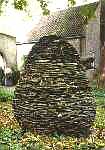 Slate cone - 1990 |
 Gouda Municipal Museum |
| Andy Goldworthy describes how he made some of his works in the book "A collaboration with nature": |
|
Ice arch - left to freeze overnight - befor supporting pile of stones removed - (made in a field with cows, a tense wait) - pissed on stones too frozen to come out - fourth attempt successful - other three arches collapsed or melted - 1982 | Lay down as it started raining or snowing - waited until the ground became or covered with snow before getting up (leaving a temporary imprint of his body on the ground) - 1984 |
1970 - Louis le Roy bought a piece of land in Heerenveen (Holland) and dumped a load of rubble on it. Then he left it alone. In a few years it had become a paradise of spontaneous vegetation.
1970 - Jan Dibbets photographed the appearing and
disappearing light in the Van Abbe Museum in Eindhoven.
He created a visual experience of the passage of time. (The
Shortest Day at the Van Abbemuseum - fragment shown)
|
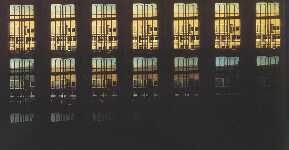 |
1972 - Jochen Gerz posed for two hours in the street beside a photograph that represented him at the same spot, in the same attire, and at the same size. It became apparent that the majority of the Basel passersby were most interested in the photograph and less in the "life" artist.
1972 - Charles Ross has made an interesting series of conceptual works using sunlight. From September 1971 to September 1972 the artist placed a wooden plank at the focal point of a large stationary lens to record the heat of the sun for that day. The burn marks created by the sunlight traced the movements of the sun in relation to the earth from New York City. (Sunlight Convergence / Solar Burns, 1971-1972)
1972 - The group "Cyclamen Cyclists" present a form of ritual street- and landscape theatre: brightly clad figures move in predetermined sequences across the landscape planting coloured flags, or performing simple physical actions.
1972 - In the north of Paris, close to an expressway, Jochen Gerz placed himself 200 feet from a video camera, shouting hello as loudly and as long as he could. Halfway through the video tape his voice had changed considerably; in the end it had become inaudible. Put differently, the distance between the man and the medium had become insurmountable.
1974 - Brygida Wrobel-Kulik built tiny gardens (30 x 30 cm) out of found objects in the landscape. She used stones, strings, feathers, twigs, small fruit-crates and soil. She photographed and documented these temporary, and virtually invisible, installations. The gardens are seen as a source of inspiration, a kind of exciting deserted landscape, a small universe and a symbol of the world. They have the shape of a triangle, a rectangle or a circle and are always related to the bigger landscape around them.
1975 ? - Terry Fox: I "played" a 4-inch food-cover for twenty-four hours in a hundred-foot-long tunnel in Montana. "You could barely hear it outside, it was a really dreamy sound, but this little thing managed to set up standing-wave patterns in there that would just create REALLY LOUD booms and it was unbelievable!"
1976 - In the video Truth Through Mass Individuation Bill Viola references Carl Jung. An isolated figure is seen performing successively more aggressive actions dropping a cymbal among a flock of pigeons and firing a rifle in a deserted city street. In the fourth and final stage, his luminous image, spotlit against the dark night, merges in the distance with a roaring crowd in an outdoor stadium.
1978 - Ana Mendieta was a Cuban-born performance artist. Her Silueta photographs record her presence in the landscape. In one of the works the subtle change of color and texture of the grass is the result of an application of fertilizer on the imprint left there by her body. The artwork could be read as specifically female, as it suggests a collaboration with nature rather than an intervention into it or an objective documentation of it. Untitled (from the series Silueta) http://www.etsetb.upc.es/carne/0297/mendieta/index.html
| 1979 - Bill Viola writes: | The video Sodium Vapor was recorded over a period of several weeks in the hours between one and five in the morning on the streets of an industrial area in lower Manhattan. The title derives from an interest in the particular qualities of sodium vapour street lighting, its characteristic colour temperature, the shadows it casts, and the eerie quality it seems to impart to the objects it illuminates. The essence of the work is the spell which the hour has over the physical spaces of the streets in the early morning. There is always the unseen presence of the large number of people surrounding you, most of them sleeping; the camera is awake in their dreamtime. The recording of these locations in the middle of the night rather than in daylight represents a transformation like figure/ground reversal of these physical spaces from the familiar thoughts and activities of the day to the night-time shadows of emptiness and obscurity. |
1979 - Gerrit van Bakel photographed the sunset every day, during the period between 22 October and 30 November of 1979. The spot was a hill called "De Bult" at the boundary between the cities of Deurne, Bakel and IJsselstein. Each photograph was taken 5 minutes before, and 5 minutes after sunset. The work is summarized in a box with 78 slides.
1980 > Some poetic works by
the Swiss artist Roman Signer:
|
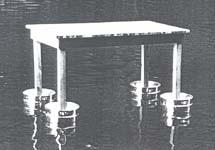 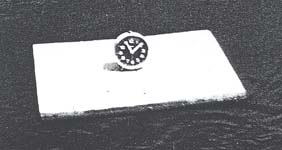 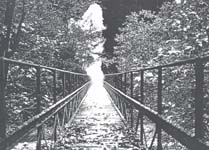 |
1980 - Gerrit van Bakel designed two huge wooden horns that would function as voice amplifiers. They would be erected in the fields at great distance from each other. Through them his brothers and his siters could tell each other things about the landscape, the landscape of their youth, without raising their voices. An aid to communication about nature between people. (Prelude for the project "Glowing man") Other of his poetic machines are:
| 1982 - In Ear to the Ground, David Van Tieghem uses the city of Manhattan as his musical instrument, playing the surfaces of the sidewalks, buildings and phone booths with his drumsticks to elicit an ingenious range of percussive sounds. In Ear-Responsibility (a 1985 sequel to Ear to the Ground) the avant-garde percussionist David Van Tieghem roamed the streets of New York, discovering the inherent rhythms and music in ordinary objects, from sidewalks to subway cars. |  |
1982 - Christian Hasucha attached viewers (binoculars) to lampposts and street signs. The viewers contained a stereoscopic colour picture. A person looking into the viewer saw exactly the same street-scenery (billboards, traffic-lights, buildings, construction sites etc.) that he could see with the naked eye.
1982 > Many works of Bill Viola are about intensified perception the world and the perception of time. In an interview Bill Viola says:
| 1983 - Alan Wood created a tribute to ranch architecture. Throughout the winter and early spring Wood and his crew were busy making the components of a threedimensional painting. These included a lifesize water tank and windmill, barns of different sizes, gates, and miles of fencing. Constructed of over 150,000 board-feet of lumber, the components were then knocked down and fed through a homemade machine that wrapped them in a continuous strip of canvas and bathed them with a coat of primer paint. Loaded on flatbeds, these stacks of brilliantly colorful elements were trucked over the Rocky Mountains to Alberta in the late spring. There, they were reassembled at a working ranch about twenty miles west of Calgary. |  |
1983 - Gerrit van Bakel constructed two long tubes (6m) aimed at the North celestial pole. He hoped that he would be able to see the North Star during daytime by eliminating the diffused light of the sky. The viewer gazes through a dark tunnel, and at the end he sees a point of light. (Telescope for the North Star)
1983 - David Nash swapped two rings of earth and vegetation in Kensington Gardens in London. The aim was to make a living sculpture that was not optically conspicuous. (Sod Swap)
1984 - Gerrit van Bakel made a construction of two very long poles, at right angles to each other. Anyone who wanted to follow the sunset and to extend that moment would seat himself on the end of one pole. Then he would be raised very slowly - lengthening the experience of sunset. The work is about the elusive quality of that impressive moment - that to the primitive mind was also a moment of terror. (Follower of the sunset III)
1986 - The German artist Wolfgang Laib collected bright yellow pine pollen from the forest and dusted it into a large rectangle on the floor of the Hayward Gallery in London. The visitors were only allowed to see and to smell the work from the entrance of the room.
1988 - The modern art museum contains many objects that can be found in any other space. Things like furniture, plants, signs, and lighting are all present. But these objects are treated as annoying distractions and are made as inconspicuous as possible. Kate Ericson and Mel Ziegier collected autographs of the workers who produced such industrial fixtures as the track lighting, the windowpanes, and the furniture in the Museum of Modern Art. These signatures were then silk-screened onto the wall next to the objects to assert the workers' artistic involvement in what is generally regarded as an anonymous and irrelevant contribution to the museum. (Signature Piece)
| 19xx > Gregor Schneider has transformed his house (Unterheydener Straße, Rheydt, Germany) in a permanent artwork. There are layers of walls and windows, one behind the other, a completely isolated guestrooms (with sound- and radiation-absorbing walls 60cm thick), a slowly revolving room, so you never know where the door will lead to, dark spaces in between the layers, cellars, fake windows letting in fake daylight. | 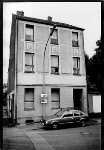 |
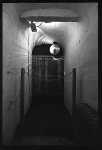 |
1991 - Shelagh Wakely spread a thin layer of curcuma (yellow coloured spice) on the travertine floor of the British School in Rome. The movement of visitors gradually erased the initial patterns of the spice-layer. The work lasted for only one week. (Curcuma sul travertino)
| 1991 - On March 18, 1990 several priceless artworks
(by Degas, Rembrandt, Flinck, Manet, and Vermeer) were
stolen from the Isabella Stewart Gardner Museum in Boston
by burglars disguised as police officers. In front of the empty spaces Sophie Calle interviewed curators, guards, and other staff members about their recollections of the missing objects. (Last Seen...) |
|
1991 - Jorma Puranen used ethnographic pictorial material in his untitled series of photographs. Puranen first made proofs on transparent plates of photographs of the Sami taken by ethnographers and researchers, then superimposed them upon pictures of the Sami's original landscapes, and finally photographed the whole scene once more. (Imaginary Homecoming series)
| 1993 - The Center for Land Use Interpretation (CLUI) designed the Sound Emitting Device (SED). The device contains a looped audio cassette mechanism, amplifier and speaker and is powered by solar cells. The components are housed in a weatherproof metal container mounted on the end of a 10 foot long steel pole. One SED is located in the forest of central Maine, in a remote area, at least 10 miles from the nearest small community. It emits the sound of a tree falling, once every evening. Another SED is located in the middle of Owens (dry) Lake, California. It emits the sound of running water, continuously during the day. | 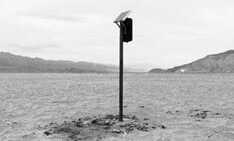 |
1993 - Leo Schatzl fenced in a 1000 sq. Meter area behind a 4 meter high wire fence. The area was situated in the Austrian village of Münzbach and was to be isolated from every human influence for 5 years. A camera makes a picture of the area every 15 minutes. After 5 years the pictures will be edited into a 40 minute film. The project was initiated with all the usual pomp and circumstance of a small village: a brass band, speeches by local authorities, consecration by the parish-priest and a beer-party. (Tabu Zone #2) www.taboo.at
1995 - Iris Häussler (München) devised a meeting with a fictional guest in room 408 of Hotel Leipziger Hof. Any guest asking for a one-person room could sleep in room 408. Here the artist had arranged the personal belongings of an imaginary guest. The challenge was to reconstruct the personal history of this imaginary person from the traces he left in the hotel room. In 1993 she covered a Milanese hotel room with thick layer wax (windows, doors, everything) creating a subdued surrealistic mood.
Other works by the artist create more fictional urban personalities. The spectator must recreate their history from the objects they left in their living spaces:
| 1995 - Gillian Wearing placed stationary cameras in the upper corners of the empty Hayward gallery and filmed goofy gangs of cowboy-actors shooting at each other. Four actors dressed as museum guards periodically stepped into the shootout, bundled the leftover "corpses" in bubble wrap, and dragged them away from the galleries. Oblivious to their presence, the cowboys, sometimes followed by their women, ran back and forth, chasing and shooting at their rivals.(Western Security) | 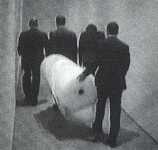 |
"Those white spaces usually command such respect, and I like the complete disrespect of it. How many times have you been to a gallery and had pure fun? It's always very contrived fun...." |
1995 - Dove Bradshaw exhibited seven linen leaves, silvered on both sides, which had been placed between chemically active flats for a period of two years, allowing a natural process of oxidation and permutation to begin and progress. (Contingency [book], 1995-97) http://www.artseensoho.com/Art/GERING/dove98/dove.html
| 1995 > Servet Koçyigit (Ankara, Turkey) makes photographs of situations that he encounters in everyday life. They often involve striking arrangements of things, or small objects that he finds in his studio or outside on the street. Sometimes he makes the arrangements himself, or he stages a particular effect: | |
|
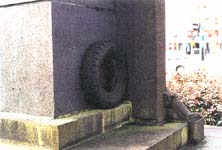 |
1996 - Nina Levy suspended 170 small, multicoloured bead-like heads from the gnarled branches of two Australian tea trees in the centre of MCA's garden. The heads were linked together like chains, their vivid colours glowing from within as they captured the light of sunset. (infantile tree ornaments)
1996 - At the exhibition in the Kunsthalle Bern, Gregor Schneider installed a new wall in front of an existing museum wall. The new wall was an exact replica of the exisiting wall and therefore was almost invisible as an artwork. But it was present anyway.
1996 - Helen Mayer Harrison & Newton Harrison planted a meadow on the roof of the BRD gallery in Bonn. In 1997 they distributed the hay from the roof over a 4000 sq. meter area in a public park. The goal is to re-introduce more than 100 species of grasses and weeds into the (usually mono-cultural) green areas of the city. (Future garden, Part 1)
| 1997 - Mauricio Cattelan made a human-like figure, made out of rubber, dressed in a suit (jacket and trousers), with the feet in a block of cement (the famous "cement shoes") - done in the best gangster tradition. The body - or, better said - the "corpse", was sunk in a shallow part of the lake, so that it was visible from the surface. The work has a certain peculiar charm: that of bell towers, small villages, and monsters occupying a lake, all of which for various reasons, have become the stuff of which legends are made. (Out of the blue) | 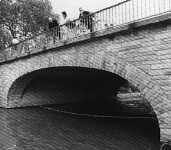 |
| 1997 - Karin Sander determined the center of gravity of the city of Münster and marked the exact spot with a red disk 130 cm in diameter, a size which corresponds to the margin of error for the calculation. The center of gravity center is located in the garden between Von-Kluck-Straße 34 and 36 on the boundary between a private lot and the grounds of a Catholic girls’ school far outside the historic town center. This place is thus recovered from anonymity. Like other city sights, the newly defined place will be illustrated on a picture postcard. | 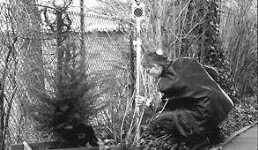 |
 |
| 19xx > Gilbert & George made large photographic works and they used old fashioned graffiti that they found on the walls of London. They showed enlargements of words like "fuck", "cunt", "suck" and "queer" that had been painted on old brick walls. | " Imagine the intensity of someone going into an old alley at night and writing words like these on the walls. Imagine the level of frustration or anger that someone like that must feel. We cannot provide this level of intensity, and that's why we use other people's graffiti. " |
1997 - Michael Asher placed a trailer home in nondescript places in the city of Münster. The location changed weekly.
| 1997 - Chris Burden built four models of bridges out of massive quantities of toy metal construction parts (Meccano and Erector). With the help of a toy metal construction expert, he was able to locate large quantities of the old and rare parts and restore them to a new, pristine state. | 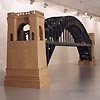 |
The Mexican Bridge was designed in the 1860’s to span the 1000 foot wide Metlac Gorge in Mexico, but it was never built. The illustration of this bridge in a book of Mexican railroads struck Mr. Burden as very beautiful and he fantasized for years about the possibility of building it using Meccano parts. In the fall of 1997 he started on this daunting project. |
1998 - Atelier Alias from Dessau (Germany) designed three types of portable and nomadic urban gardens: a Rose-garden, a Palm-garden and a Japanese garden. The Japanese garden was made from potted plants, rectangular tiles covered with grass and moss, bamboo mats and stones. The gardens moved through the city and settled at unused and unnoticed spots. The artists (Katja Heinecke, Reinhard Krehl, Bertram Weisshaar) wanted to focus attention on the neglected and suppressed "white spots" of the city.
| 1998 - A photograph shows the artist Job Koelewijn in New York. He's balancing a 4m high stack of beer-glasses and trays in his hand (tray - beer-glass - inverted beer-glass - tray etc.). Any moment the uneasy stack will collapse. But the stack also harmonises very well with the skyscrapers in the background. "How could you compare a small human being with such a city full of high buildings. The attempt is doomed to fail. But it's worth trying." (Balancing act). | "In New York I had the feeling of living between fiction and reality. All my memories from television were passing by. So we built a small theatre inside a container with a glass window that shows the reality outside. Inside you hear music from "Once upon a time in the West". If you sit there, you lose your sense of the difference between reality and fiction. And the people who pass in front of the screen become actors without even knowing it." |
1998 - Dino Bruzzone (Argentina) makes meticulous cardboard models of technical installations (like power-stations, electricity substations) and the he makes photographs of the models. The artificial cityscapes, devoid of people suggest a feeling of strangeness, solitude and disquiet.
| 1999 ? - The Rotterdam
philosopher Eugene Buskens built a high, unstable pyramid
out of plastic glasses filled with water. He did it
during the Saturday market in the marketplace. "I
just try to keep on building. I have had to start over a
few times. But the goal is not to make an object. The
goal is the process of building." Some children from the public helped him enthusiastically. At the end of the market day a bystander was invited to stand on top of the pyramid. But the structure toppled at the first attempt. The children finished the job with a wild water-battle. |
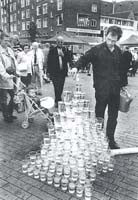 |
1999 - On the eve of the millennium Cai Guo-qiang (1957, Ghuanghou, China) recreated an old and familiar image. At the opening of the exhibition, 2000 green plumes of smoke were released from 2000 chimneys in the city of Utrecht - as if everyone was peacefully engaged in the preparation of their evening meal. This is how Holland could have looked at the end of the 19th Century. (The Last Supper - Aesthesized Nature). - 'Projects for Extraterrestrials' is a series of firework-projects that has made the artist internationally famous. Currently a resident of New York, Cai uses fireworks to make drawings that are executed from the perspective of an extraterrestrial situated far from our planet.
| 1999 > Jim Denevan makes huge sanddrawings on the beach. The drawings are unmeasured, freehand and are made without surveying equipment or help from technical means. Enormous, existing for a moment, then washed away. By now Jim has completed more than 11,000 miles of over a period of 6 years. A film about his activities has also been made called -SANDMAN- http://www.jimdenevan.com/ | 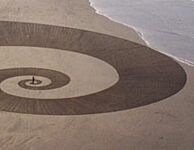 |
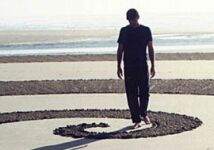 |
1999 - Roman Signer devised a soundwork for the city of Utrecht. A wooden box is placed on the roof of the Public Library. At the 40-metre gallery of the Domtower, there is a microphone and a button which visitors can press to operate the artwork. When the button is pressed, two doors open in the box, and a loudspeaker appears. Everything the visitor says into the microphone is then returned as an echo.
1999 - Arnoud Holleman was invited to make an artwork for the new city-hall of the region of Dantumadeel (Friesland, The Netherlands). But he did not make a new original artwork. He explored the forgotten closets, old boxes, archives, and back-rooms of the city-hall and used the objects he found there. (Collection of collections) In this way he downplayed his own identity but strengthened the identity of the region, the town-hall and its employees:
| 2000 > Megan Shaw Prelinger and Rick Prelinger began to place coins (of their own design) at various sites. In doing so, they mark places they believe deserve special attention and thought. Some sites have been chosen because they are rich with memory. Some mark the location of major or minor (but significant) historical or cultural events. Other sites are contested places - places where people have fought for ownership or control of land, resources, or communities. http://home.earthlink.net/~alysons/coin.html | The coins are meant to be found by anyone - residents, explorers, workers, tourists, and people who play at the sites where we have left them. We leave them in the hope that finders will reflect upon their meaning, contemplate the landscape where they were found, and ponder what hidden histories might be mapped there. We also hope that in future years, as the coins bounce in peoples' pockets and are twirled in their fingers, they will inspire reflection about landscape and history that is not limited to the site where the coin was found. |
2000 - Mehr Licht - Bright daylight-emitters are installed in three strongly frequented places under the cathedral-platform in Cologne. The three places are carefully selected for their bleak and melancholic character. The devices and their supporting grids closely resemble the usual "furniture" of public city-space. When a passer-by leans against the grid an infrared sensor activates the lamp. The passer-by can enjoy a few moments of pure sunlight in his otherwise bleak surroundings. A simple pictogram explains the use of the installation. The equipment is made from high-grade stainless steel. (Project Nr. 36 - Mehr Licht)
| 2000 - Mark Bain is an American artist living in Amsterdam working with actions that affect buildings with intense sound installations. He is mostly known for designing a system that shakes buildings with resonant frequencies and vibration. The system generates copius amounts of infrasound, which does strange things to structures and people. He has done numerous projects abroad and in Holland. |
|
2000 - Bernd W. Dürebett-Schlothauer opened a hot dog stand (more precisely: Bratwurst-Stand) for the public. The artist sees the "Bratwurst" as a "fast-food for a restless, accelerated time". At the same time the artist transformed "art-history into food" by sticking a paper flag in every hot-dog (Bratwurst) bearing the name of a deceased artist.
| 2000 - Barbara Schmidt put up a throne (in fact a high chair, like the ones used by tennis-umpires) in the middle of a public square in Hamburg. She invited passers-by to sit on it. - "By sitting on this high throne your perception of space and your perception of yourself is changed." |  |
2000 - Regina Hellwig-Schmid has organised the project "Pax Danubia". On 23 September the participants will package their personal artworks in bottles and float them down the Danube. The artworks will be launched from 18 different locations along the shore of the river (from Ismail to Donaueschingen).
2001 ? - An (as yet unidentified) artist (or
collective) has designed the "Criminorama - Dark
Oss". Oss is an undistinguished city in the south of
the Netherlands. The exhibition delves into the criminal
history of the city and tries to show that Oss and its
inhabitants have always been extremely violent and
criminally inclined. Some exhibits are:
The whole exhibit looks realistic but it is very politically incorrect. A closer look reveals that all the exhibits and histories are fake and have no relation to reality. (Criminorama Donker Oss) |
 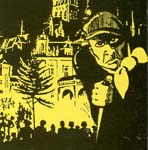 |
2001 - Some unexpected artworks
in Hoek van Holland (The Netherlands):
|
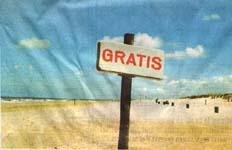 |
Others - Sometimes not classifiable but worthwhile
| 1750 - Giovanni Battista Piranesi etches the Carceri d'Invenzione. These imaginary cellars and prisons are the wet dream of every urban explorer. You can explore these paper spaces and get lost in them. The Carceri are Piranesi's sublime dreams; a nightmare world of cavernous jails, containing stairways that lead nowhere, pulleys and chains that have no purpose and peopled by tiny contorted figures, overwhelmed by their monumental surroundings. The effect is frightening and claustrophobic, an atmosphere produced by spatial ambiguities and lighting techniques. Of course this format doesn't do them justice - go to the library - do it now! | 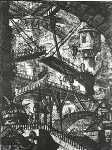 |
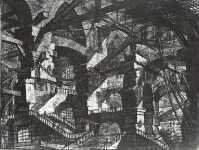 |
1958 > Christo has completed many ambitious projects, including wrapping buildings (Reichstag, Berlin), bridges (Pont Neuf, Paris), surrounding islands with floating plastic skirts and fencing in miles of coastline and inland hills. All these have taken years of planning, meetings, negotiation, court hearings and most of all, patience. The projects are site-specific and last only a few days or weeks. (1969, Wrapped coast, One million square feet, Little Bay, Sydney, Australia, 1972, Running fence, Marin country California)
1967 – Dennis Oppenheim would find an o object that had lain in the dirt in a vacant lot (in New York City, Amsterdam, or Paris) and would remove it, leaving the indentation of its own shape in the dirt. The site would be photographed both before and after the removal. The indentation, that is, the absence rather than the presence of an object, was the artwork. (Indentations)
1967 - Claes Oldenburg installed "Invisible sculpture" behind the Metropolitan Museum of Art by digging and refilling a trench.
1969 – Tom Marioni first created a fictive character Allan Fish. As Allan Fish he organized the performance “The Act of drinking Beer with Friends is the highest Form of Art”. He invited 21 friends to come and drink beer at the Oakland museum. 16 people came. The leftovers – beer cans, cigarette butts - were exhibited as documentation of the activity. – Later he organized the piece “Allan Fish drinks a Case of Beer” in the Reese Pailey Gallery. – To separate himself from the public he ran a thread at a 30-degree angle across the room. The thread was white for the first floor, then black across the room and white for the last foot against the wall. It looked like a thin black line floating. – At the Demarco Gallery in Edinburgh he did a vertical line drawing until the pencil was used up.
1969 – Robert Barry organized the Inert Gas Exhibition and executed it in different places around Los Angeles. - We released fife colorless and odorless noble gases into the atmosphere. The only tangible trace of these exhibitions was the poster with the announcements. There was no gallery and the object was invisible. Some people threw it away then. Today the poster is a valuable collector's item.
1969 > Jeff Wall, a conceptual photographer from
Canada is famous for his translucent cibachrome
transparencies with the size and composition of
historical paintings. Several of his works show the
ragged edges of town, the same places that Urban
Explorers like to visit. One of his works even shows a
drain:
|
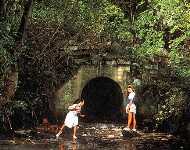 |
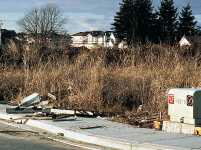 |
1973 - Michael Asher sandblasted the walls of Toselli-gallery in Milan removing all the layers of white paint and again showing the bare walls. The artwork was identical to the area of it’s presentation.
1979 - Michael Asher removed the statue of George Washington from the entrance of the Art Institute of Chicago and replaced it in Gallery 219 as part of his installation.
1990? - For his video piece "Forever"Beijing based artist Zhu Jia attached a Hi 8 camera onto a bicycle wheel and rode the bicycle on the streets and travelled through the city. The camera recorded an astonishing sequence of images of the fragmentation of the cityscape.
1992 - In her 1992 photographic piece London-based artist Gillian Wearing focuses on the individual. She intercepted random passers-by on the street and asked them to write messages of their own choosing on large pieces of paper. The results are almost painfully intimate. Particularly moving is the photograph of a mild-mannered young businessman whose sign reads simply, "I'm Desperate." ( Signs that say what you want them to say and not Signs that say what someone else wants you to say.)
1996 - Friedman took everything out of his studio and created a white, empty space. He used this space to explore his own experience of ordinary things. Every day he scrutinized and explored a different object in this self-imposed, fluorescent cell: a metronome, a plate, some honey, a jigsaw puzzle. "I started writing down as many questions as I possibly could. I asked what I knew about it, where did it come from, how was it made, why was it made, what is it used for, what is its color or texture...." This way the artist managed to filled 20 pages with observations about a single coffee filter. http://hotwired.lycos.com/gallery/96/46/profile.html - http://hotwired.lycos.com/gallery/96/46/index4a.html
1998 - Braco Dimitrijevic took a photograph of a rondom passer-by on London's Waterloo bridge and made it into a banner which was hung outside the nearby Hayward Gallery. The superhuman scale of The casual passer by I met served to question the status of public images.
1998 - Sound Mapping is a collaborative project by Iain Mott, Marc Raszewski and Jim Sosnin. The project uses four movement-sensitive, sound producing suitcases that play music in response to nearby architectural features and the movements of the participants. Individuals can wheel the suitcases through a specified district of the city following a path of their choice. The suitcases determine their position using the Global Positioning System (GPS), which tracks movement of individuals through the space. In this way a non-linear algorithmic composition is constructed to map the footpaths, roadways and open spaces of the region and the interaction of participating individuals.
| 2000 - The installations of Jonathan Meese look like a bohemian squatter's lumber room, with labyrinths of narrow passages, staircases leading down to the original ground level, and arcades built into the space beneath these passages. The artist re-creates his little big worlds of troubling great details, photos, seventies poster, objects and writings. A lof of found objects are incorporated into the installations. The specific exhibition at Paolo Curti & Co. Gallery (Milan, Italy) referred to a movie of 1940 titled “Dr. Cyclops”, directed by Ernest Beumont Shoedsack, who was the director of the famous “King Kong” in 1930. The show included paintings, installations, drawings, photos, sculptures and lightboxes. http://www.paolocurti.com/ http://www.paolocurti.com/meese/meese.htm |  |
 |
2000 - Jack van Mildert has started a foundation to buy pieces of land where weeds and bushes can grow as they like. His plan is to re-create the adventure-terrains that he remembers from his youth. They should be wild and more adventurous than the regulated nature of parks, gardens and even nature-reserves. Useless areas have their own special beauty. (Stimuleringsfonds voor avontuurlijk groen in de polder, SAP)
| 2001 - Jeroen Jongeleen organized the "First Illegal Dutch Hateparade". The participants carried signs that had been torn from billboards. Most visible were advertisements for parties, concerts and sex-shops. | 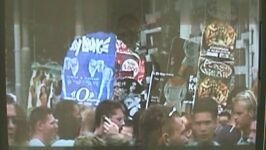 |
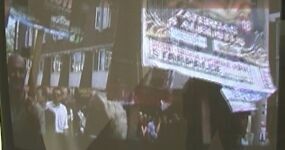 |
| 2002 - San Keller leaves you money in the gutter. - The artist lines up a chain of 5-Rappen (5 cent) coins in an 1 kilometre circle around Zurich Paradeplatz. With one tenth of your monthly salary you can let this chain shine! Release some of your capital for this project. San Keller will tell you when and where you can give him your tithe in 5-Rappen-coins to start the action. On Saturday 16 February 2002 San Keller will lay one tenth of his monthly income on the street. Hereby you are cordially invited to bring along one tenth of your own income. - sankeller@bluewin.ch - http://www.haben.ch/files/sk2.html | 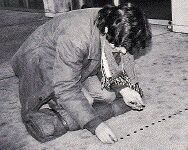 |
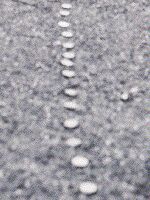 |
| 2002 - Thasnai Sethaseree has coordinated one exhibition that runs concurrently in three countries. Each space will present tourist photos taken in Thailand. The photos presented in Chicago will be Japanese tourists' photos of Thailand (over 400 photos). The photos in Japan will be American tourists' photos of Thailand. And in Bangkok, the photos will all be from Thai people. (Thailand is not my idea) | |
| When tourists and travellers take snapshots, are they attempting to document an objective portrait of the matters at hand? Or are these merely memory aids? A businessman takes a photo of the Chiang Mai train schedule to compare to all the other stations he has passed through. A smirking teenager poses with two glamorous showgirls for bragging proof to his buddies at home. A young woman takes a portrait surrounded by extended elderly relations so her future child knows where her name comes from. |  |
Back to: Urban Adventure in Rotterdam
© 1999 Petr Kazil - 28 January 2000